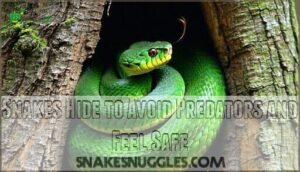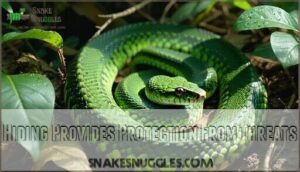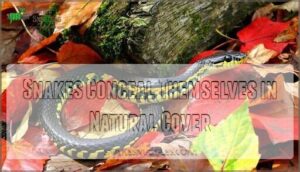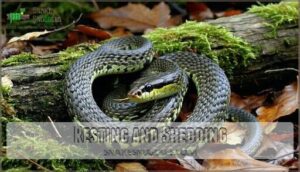This site is supported by our readers. We may earn a commission, at no cost to you, if you purchase through links.
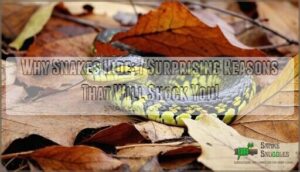 You’ll discover that snakes hide for survival reasons that go beyond simple fear.
You’ll discover that snakes hide for survival reasons that go beyond simple fear.
These clever reptiles use hiding as their primary defense against predators like hawks, owls, and larger mammals.
Since they’re cold-blooded, snakes also seek shelter to regulate their body temperature and maintain proper humidity levels.
Hiding spots serve as perfect ambush points where they can strike unsuspecting prey.
During vulnerable times like shedding their skin or mating, concealment becomes even more critical.
Snakes naturally avoid human activity by retreating to secluded areas where they feel secure.
Their hiding behavior is like nature’s own game of hide-and-seek, with much higher stakes than you might imagine.
It is a matter of survival, and snakes have mastered the art of remaining hidden to protect themselves from predators.
Table Of Contents
- Key Takeaways
- Why Snakes Hide?
- Seeking Safety and Security
- Thermoregulation and Comfort
- Hunting and Feeding
- Reproduction and Nesting
- Avoiding Disturbance
- Resting and Shedding
- Frequently Asked Questions (FAQs)
- Why do snakes hide?
- Why does the snake hide itself?
- How long will a snake stay in hiding?
- What to do if a snake is hiding?
- What does it mean when your snake hides?
- Why do snakes like to hide?
- Why is snake hiding important for pet reptiles?
- Why do snakes hide in cages?
- Why should you buy a snake hide?
- Do you need a snake hideout?
- Conclusion
Key Takeaways
- You’ll find snakes hide primarily for survival – they’re avoiding predators like hawks and larger mammals while creating secure environments where they can rest without constant worry about threats.
- Your snake’s hiding behavior is actually temperature control – since they’re cold-blooded, they seek shelter to regulate body heat and maintain proper humidity levels for their ectothermic needs.
- You’re witnessing strategic hunting when snakes hide – they use concealed locations as ambush points to surprise unsuspecting prey, making their hunting incredibly efficient through patient waiting.
- You should respect their hiding during vulnerable times – snakes need secure spots when they’re shedding skin, digesting food, or reproducing, and forcing interaction during these periods causes unnecessary stress.
Why Snakes Hide?
You’ve probably wondered why your snake spends so much time tucked away in its favorite hiding spot.
Snake hiding behavior isn’t just quirky – it’s essential survival instinct.
Snakes hide for temperature control, predator avoidance, hunting success, and stress reduction.
Understanding these snake hiding reasons helps you create better Natural Habitat Design and recognize important Hiding Health Indicators in your pet.
Seeking Safety and Security
When you think about a snake’s daily life, you’ll realize that staying hidden isn’t just a preference—it’s a survival strategy.
Snakes use natural hiding spots like rocks, logs, and thick vegetation to protect themselves from predators and create a secure environment where they can rest without worry.
Snakes Hide to Avoid Predators and Feel Safe
Snake hiding behavior stems from millions of years of instinctual behavior.
Your snake’s hiding instincts are ancient survival wisdom hardwired into their DNA—respect this natural behavior and they’ll thrive.
When you observe snakes seeking secure shelters, you’re witnessing natural predator avoidance in action.
This habitat security strategy includes:
- Camouflage tactics that blend with surroundings
- Stress reduction through protected spaces
- Hiding instincts that trigger automatically when threatened
- Natural behavior patterns inherited from wild ancestors
Many snakes also use defensive coiling tactics to protect themselves.
Hiding Provides Protection From Threats
When you’re a snake, hiding isn’t just smart—it’s survival.
Predator Avoidance drives this natural instinct as snakes seek secure retreats from birds of prey, mammals, and other threats.
Their concealment strategies rely on camouflage benefits, blending seamlessly into surroundings.
These survival instincts create effective snake hiding places where they remain undetected.
To reduce stress, snakes require appropriate snake hides within their enclosures.
This snake behavior guarantees protection when they’re most vulnerable.
Snakes Conceal Themselves in Natural Cover
Mastering camouflage strategies, you’ll find snakes choosing perfect hiding spots in nature’s buffet of cover options.
Their habitat selection relies on natural instincts for survival.
Here are key snake hiding places they prefer:
- Rotted logs – Perfect microhabitat preferences for moisture and protection
- Rodent burrows – Ready-made tunnels for predator evasion
- Leaf piles – Seasonal hiding spots with natural camouflage techniques
- Rock crevices – Secure snake hiding habitat year-round
- Dense vegetation – Natural cover for ambush opportunities.
Snakes often require safe natural habitats to thrive.
Thermoregulation and Comfort
You might think snakes hide only to avoid danger, but they’re actually managing their body temperature like a natural thermostat.
Since snakes can’t produce their own heat, they’ll seek out cool hiding spots when it’s too warm or find warmer shelters when they need to heat up to regulate their body temperature efficiently with their thermostat.
Snakes Hide to Regulate Their Body Temperature
Unlike warm-blooded animals, you’ll find snakes are ectothermic creatures that depend entirely on their environment for body heat.
Snakes are nature’s living thermostats, constantly seeking the perfect temperature hideaway to survive and thrive.
They hide strategically to maintain ideal temperatures through microclimate control and temperature gradients in their habitat.
- Seasonal hiding patterns change as outdoor temperatures fluctuate throughout the year
- Snake temperature regulation requires constant adjustment between warm and cool zones
- Thermoregulation becomes easier when snakes access multiple temperature options in hiding spots
- Snake behavior patterns show increased hiding during extreme weather conditions
- Habitat warmth conservation helps snakes maintain energy for essential bodily functions
To guarantee proper thermoregulation, consider setting up a thermostat for precise control.
Sheltered Areas Offer The Right Temperature and Humidity
Finding the perfect hiding spot isn’t just about safety for snakes—it’s about creating their ideal microclimate.
These sheltered areas maintain perfect temperature and humidity levels that support their ectothermic needs.
You’ll find snakes choosing spots that offer humidity balance and temperature regulation benefits, helping them maintain proper hydration and body heat without constantly moving around their enclosure setup.
Snakes also require hides to reduce stress, as they provide a safe retreat.
Hiding Helps Snakes Conserve Energy and Avoid Stress
Beyond finding the perfect temperature, snakes use hiding spots as their personal energy-saving stations.
These sheltered areas reduce stress by shielding them from constant threats and disturbances.
In captive environments, proper hiding spots support natural behavior and deliver significant health benefits by minimizing energy expenditure.
3 Ways Hiding Conserves Snake Energy:
- Reduced vigilance – Less time scanning for predators means more energy for growth
- Minimized movement – Staying put conserves calories for hunting and digestion
- Stress-free rest – Uninterrupted sleep cycles optimize metabolic efficiency
Hunting and Feeding
You mightn’t realize it, but snakes are master hunters who use hiding spots as their secret weapon for catching prey.
When you watch a snake disappear into tall grass or under a rock, it’s actually setting up the perfect ambush to surprise unsuspecting rodents, birds, and insects that wander too close.
Snakes Hide to Ambush Prey More Effectively
Strategic concealment transforms snakes into deadly efficient hunters.
You’ll find timber rattlesnakes and other species using ambush tactics to maximize their hunting success.
Their camouflage advantage and snake natural instincts help them remain motionless for hours, waiting for prey to wander within perfect strike distance.
This predatory efficiency through ambush hunting makes snake hunting techniques remarkably effective in the wild.
Concealed Locations Allow Snakes to Surprise Their Targets
You’ll find that concealed attacks make snakes incredibly effective hunters.
Their strategic position behind rocks or thick grass gives them serious advantages through ambush tactics:
- Perfect camouflage blends them into surroundings
- Enhanced sensory detection of prey movement
- Quick strike capability with secure escape routes
- Territory protection while maintaining hunting success
This natural behavior maximizes predatory efficiency through patient ambush hunting.
Creating a hospitable environment with rock piles for shelter can encourage their presence.
Hiding Spots Provide Access to Food Sources
You’ll notice snakes choose hiding spots near abundant food sources like rodent nests and bird roosts.
These strategic concealment locations boost hunting success dramatically.
Snake hiding habits center around predatory efficiency – they’ll wait motionless near prey trails for hours.
Ambush tactics work best when snakes position themselves between food and water sources, maximizing their chances of catching unsuspecting rodents.
Reproduction and Nesting
When you think about snake reproduction, you’ll discover that hiding plays a vital role in their breeding success.
Female snakes seek out secure, hidden locations to lay their eggs or give birth, protecting their offspring from predators and harsh weather conditions, which is crucial for their breeding success.
Snakes Hide to Find Suitable Breeding Grounds
In terms of reproductive success, you’ll find snakes aren’t just looking for any spot to breed.
They’re incredibly selective about their breeding grounds, choosing locations that offer maximum habitat seclusion and ideal habitat conditions.
Nesting camouflage is essential for protecting their future offspring from hungry predators.
Here’s what makes perfect snake habitats for reproduction:
- Dense vegetation that provides natural cover and concealment
- Stable temperature zones that maintain consistent warmth for egg development
- Moisture-rich environments that prevent eggs from drying out
Parental security drives these natural behaviors, ensuring reproductive success through strategic hiding spots.
Hiding Spots Offer Protection for Snake Offspring
Snake mothers don’t stick around for long, but they’re smart about egg protection. You’ll find their nests tucked under logs, rocks, or thick vegetation where nest camouflage keeps eggs hidden from hungry predators.
While parental care is minimal, these hiding spots give baby snakes their best shot at hatchling survival. Some owners even utilize specialized protection products to increase the chances of successful hatching.
| Protection Method | Location Examples | Survival Benefit |
|---|---|---|
| Nest Camouflage | Leaf piles, rotting logs | Blends with surroundings |
| Natural Cover | Rock crevices, dense shrubs | Shields from weather |
| Underground Sites | Burrows, soil cavities | Temperature stability |
| Predator Avoidance | Secluded areas, thick grass | Reduces detection risk |
Baby snakes adapt quickly, relying on natural cover and instinctual snake hiding behavior to survive their vulnerable early days in various snake habitats.
Avoiding Disturbance
When you’re walking through your yard or hiking on a trail, you’re creating noise and movement that snakes find threatening.
They’ll quickly retreat to hidden spots under rocks, logs, or thick vegetation to avoid any interaction with humans, since they can’t tell whether you’re a predator or just passing by, which leads them to utilize thick vegetation as a means of escape.
Snakes Hide to Escape Human Activity and Interaction
When you’re around, snakes naturally retreat to Urban Snake Havens like wall voids and cluttered spaces.
Your presence triggers stress and insecurity, making them seek hiding spots that minimize Human-Wildlife Conflict.
This snake behavior isn’t personal—it’s survival instinct.
Understanding their need for space helps develop Coexistence Strategies while supporting Habitat Preservation and Safe Snake Removal when necessary.
Hiding Allows Snakes to Avoid Perceived Threats
Beyond escaping human interaction, you’ll find snakes hiding when they sense perceived threats that trigger their natural defense instincts. Their hiding behavior helps reduce stress and insecurity by providing environmental security.
Here’s how snakes use hiding for predator avoidance:
- Detecting vibrations from approaching dangers
- Responding to sudden movements or loud sounds
- Avoiding unfamiliar scents that signal potential harm
- Seeking captive safety when feeling vulnerable, which is a key aspect of their environmental security.
Secluded Areas Provide a Sense of Security
When you’re dealing with snake insecurity, remember that secluded spots act as safe retreats.
Natural instincts drive snakes toward hiding spots that minimize disturbances. Urban cover like dense shrubs provides security, while environmental adaptation helps them blend seamlessly into surroundings.
| Hiding Location | Security Level |
|---|---|
| Dense vegetation | High |
| Rock crevices | Maximum |
| Building foundations | Moderate |
| Fallen logs | High |
Resting and Shedding
You’ll notice snakes spend considerable time hidden away during their most vulnerable periods of rest and skin shedding.
When they’re preparing to molt, snakes seek out secure hiding spots where they can retain moisture and avoid disturbance while their old skin loosens and peels away, which is a process that requires them to be in a secure location to prevent disturbance.
Snakes Hide During Periods of Inactivity and Rest
Just like you need your bedroom for peaceful sleep, snakes require hiding spots during their sleep patterns and quiet recovery periods.
These natural behaviors help with energy conservation and digestion seclusion.
During brumation behavior, they’ll seek secure locations for extended rest.
- Nocturnal species hide during daylight hours
- Diurnal snakes retreat when darkness falls
- Post-feeding hiding aids proper digestion
Hiding Facilitates The Molting Process
You’ll notice your snake hiding more before shedding begins.
This behavior connects to hormonal changes that trigger ecdysis.
Snake shedding requires high humidity for proper skin loosening, and hiding spots naturally provide these conditions.
The enclosed environment prevents retained eyecaps and supports successful molting.
Your snake’s hiding duration increases during this vulnerable time, protecting them from disturbances while their old skin prepares to come off, which is related to the process of ecdysis.
Sheltered Spots Offer a Safe Environment for Shedding
The right hiding spots transform your snake’s shedding experience into a stress-free process.
Sheltered areas in the enclosure maintain proper moisture retention, supporting healthy skin health during this vulnerable time.
Smart enclosure design includes humid hides that reduce anxiety and provide security.
Shedding frequency becomes more predictable when your snake environment offers safe, concealed spaces for this natural molting cycle.
Maintaining optimal humidity levels is essential for a smooth shed.
Frequently Asked Questions (FAQs)
Why do snakes hide?
Snakes hide because they’re naturally wired for survival.
You’ll find them seeking shelter to regulate body temperature, avoid predators, digest food safely, and reduce stress from environmental threats or human activity.
Why does the snake hide itself?
Even master escape artists need their sanctuaries.
Your snake hides because it’s hardwired for survival—seeking security, regulating body temperature, and reducing stress.
It’s not avoiding you; it’s following millions of years of natural instinct.
How long will a snake stay in hiding?
Your snake’s hiding duration depends on several factors.
During shedding, they’ll stay hidden for days or weeks.
After feeding, expect 2-3 days minimum.
Stressed snakes hide longer until they feel secure again.
What to do if a snake is hiding?
Check the temperature, provide adequate hiding spots, and resist disturbing them.
Don’t force interaction or remove their shelter.
Let them adjust naturally, ensuring proper heat gradients and multiple hide options throughout their enclosure, allowing for a natural adjustment with multiple hide options.
What does it mean when your snake hides?
When your snake hides, it’s perfectly normal behavior.
Your pet’s seeking security, regulating body temperature, or feeling stressed from environmental changes.
It doesn’t necessarily indicate illness—just natural instincts kicking in for comfort.
Why do snakes like to hide?
Protective positioning provides peace of mind for your serpentine companion. They’re naturally wired to seek shelter for thermoregulation, stress relief, and hunting strategies – it’s their built-in security system working perfectly.
Why is snake hiding important for pet reptiles?
Your pet snake needs hiding spots to feel secure and reduce stress in captivity.
These shelters help with thermoregulation, digestion, and shedding while mimicking their natural instincts for survival and comfort.
Why do snakes hide in cages?
Like a nervous student seeking refuge in a quiet corner, your captive serpent retreats to its hide box for security and comfort.
You’ll notice they’re regulating temperature, reducing stress, and following natural instincts to feel safe.
Why should you buy a snake hide?
You’ll provide essential security for your snake’s mental health.
Hides reduce stress, support natural thermoregulation, and create safe spaces for shedding.
Without proper hiding spots, snakes become anxious and may refuse food completely, which highlights the importance of proper hiding spots for their well-being, and reduce stress.
Do you need a snake hideout?
Studies show 90% of captive snakes experience stress without proper hiding spots.
You absolutely need a snake hideout – it’s essential for your pet’s physical and mental health, providing security, temperature regulation, and reducing anxiety-related behaviors.
This provides a sense of security, which is vital for the snake’s well-being.
Conclusion
Remarkably, scientists have documented over 3,000 snake species worldwide, each perfecting their hiding techniques over millions of years.
Now you understand why snakes hide isn’t just about fear—it’s a complex survival strategy.
These behaviors help them avoid predators, regulate temperature, hunt effectively, and reproduce safely.
When you encounter a snake, remember they’re simply following ancient instincts. Respecting their need for concealment guarantees both your safety and their continued survival in nature’s delicate balance.
They are acting to ensure their survival, and it is crucial to respect this need for concealment.
- https://mynatureguard.com/blog/where-do-snakes-hide-in-a-house/
- https://repticube.com/blogs/reptile-talk/the-ultimate-guide-to-reptile-hides-why-your-snake-needs-one-and-how-to-choose-the-best?srsltid=AfmBOop4x1cS0A5spC-re7iypNn5S3KHWdQdXr0AqfMRBuu3N2p4dsbj
- https://www.petplace.com/article/reptiles/general/why-does-my-snake-bury-itself
- https://cornsnake.net/pages/hides?srsltid=AfmBOorXYwzfaUaun7kiTANjO7XV0os_zriq7d63987q90O3J8UrlRKA
- https://goprowildliferemoval.com/2023/08/16/common-places-snakes-hide/

